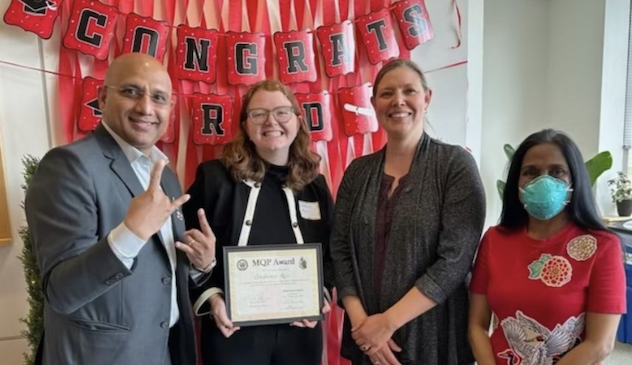Major Qualifying Project
WPI's project-oriented curriculum prepares students to engage in lifetimes of professionalism and learning. The Major Qualifying Project (MQP), a senior capstone experience, prepares students for life beyond college and gives them a leg up on the competition when it comes to launching careers and gaining admission to professional schools.
The MQP in Biology and Biotechnology (BBT) is far from trivial. It requires a substantial part of an academic year and culminates in a project report and presentation. The project can be performed in research labs, in the department's ProjectLab, or on off-campus sites such as the University of Massachusetts Medical Center, Tufts University, Brown University, Harvard University, and area biotechnology companies.
Recently Completed Major Qualifying Projects
Assessing nucleic acid aptamers for the amelioration of copper toxicity
Authors: Stephanie Reis
Advisors: Jagan, Srinivasan, Farny, Nataly
Copper (Cu) is an essential heavy metal required in regulated quantities to support cellular function. However, even though copper is required for these functions, too much copper present in an organism can be toxic and result in negative health impacts. Furthermore, copper metabolism diseases like Wilson’s disease and Menkes disease can result in negative phenotypes when the amount of Cu present is unregulated. Aptamers are short single-stranded DNA or RNA sequences that bind directly to substrates, including toxic metal ions. Aptamers have been widely used for biosensing applications but have not been investigated as prophylactics or therapeutics for heavy metal toxicity. In this study, we document the negative impacts of Cu in the model nematode Caenorhabditis elegans (C. elegans) in the form of reproductive toxicity, neurotoxicity, and survival. We show that brood size of C. elegans is reduced by 50% when exposed to 10mM of Cu, but co-exposure of the Cu binding aptamer and copper did not produce a restorative effect. We have also shown that when exposed to Cu, C. elegans showcase reduced avoidance behavior towards known repellants of glycerol and quinine. Furthermore, our results revealed that co-exposure to copper and the Cu_A2 aptamer was able to restore avoidance behavior towards the quinine repellant to wildtype levels, and restoration was not seen with co-exposure to the scramble or water treatments. Copper has also been shown to have an impact on survival where exposure led to reduced lifespans in both wildtype N2 C. elegans and VC672 strain C. elegans, which have a copper metabolism mutation. We show that co-exposure to the Cu_A2 aptamer and copper in the VC672 strain was able to extend the lifespan of the C. elegans, where longevity was not protected in the C. elegans co-exposed to the scramble or water conditions. Our results suggest that nucleic acid aptamers have potential to be used as prophylactics or therapeutics against toxic heavy metal exposures, and therefore warrant additional investigation.

Screening for ErbB Family Inhibitors to Identify Potential Cancer Therapeutics
Author: Sam Leviton
Advisors: Duffy, Joseph B.
Cell division is a highly regulated and complex process. Uncontrolled cell division occurs when regulators of cell proliferation escape normal functionality leading to cancerous states. Receptor tyrosine kinases (RTKs) are key drivers of signaling cascades that regulate cell division. The Epidermal Growth Factor Receptor (EGFR/ErbB) family is one class of RTKs whose dysregulation underlies numerous cancers. As such, searches for molecules that interact with, and inhibit, this RTK family have been ongoing for decades. Kekkon1 (Kek1), a transmembrane protein that is part of the leucine-rich-repeat (LRR) and immunoglobulin domain (Ig), LIG family, is an inhibitor that directly interacts with the Drosophila EGFR (dEGFR). Interestingly, Kek1 does not appear to do the same with the human EGFR/ErbB family. Given that there are human LIG proteins with extracellular regions similar to Kek1, the objective of this study was to test for possible interactions between these human LIGs and members of the RTK superfamily, specifically the ErbBs. The extracellular domains of ErbB proteins and a variety of human LIGs were produced – some under varying conditions to assess protocol. Their potential interaction was later tested via an ELEXIS assay. Early results indicate no significant interactions between LINX and the RTKs Ret and TrkA. Preliminary data also shows that a twelve-day transfection incubation results in higher protein expression than ten days for several LIGs.

View additional MQP’s in our project database.

Undergraduate Research Projects Showcase
In April WPI holds its annual Undergraduate Research Projects Showcase, during which students present their research to peers, faculty, and invited guests in recognition of the accomplishments they have achieved through their senior capstone experiences.
How Science, Writing, and Human Health Intertwined in Ghana
For her Major Qualifying Project, Biology & Biotechnology student Victoria Mason had the opportunity to help address a public health problem in Ghana. Residents were being infected by the Schistosomiasis parasite, which lives in the local river. Vicky tackled the problem from a scientific perspective and also leveraged her experience as a double major in Professional Writing to probe the human context in which medicine is practiced.